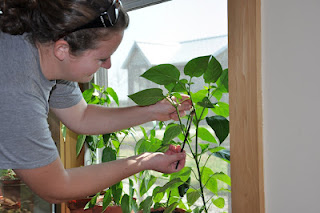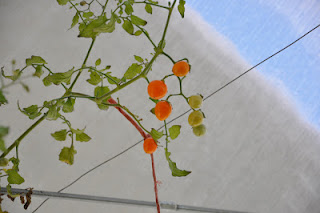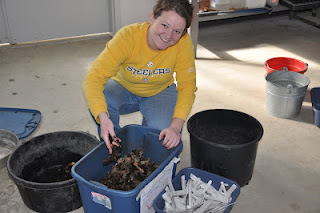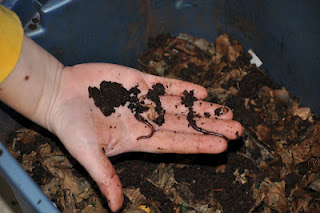Winter Tomatoes

Though the winter has been too cold for growing plants outside, we have been keeping busy with other projects here at Rieth Village. One of those projects has been season extension. In our greenhouse, the lives of many of our plants were extended well into the winter. In fact, our final tomato harvest of 2011 took place on December 1st! The picture shows a Sungold Tomato plant thriving and producing fruit with snow on the roof of the greenhouse. Also, thanks to our newly constructed hoophouse, we were able to pull some red kale all the way through the winter season. The plants are still providing us with lush, beautiful leaves!

Late in the last growing season, we had started a few pepper plants in the greenhouse. Once the nights began to get too cold for the delicate plantlets, we brought them indoors and placed them on a south-facing window sill. With a little t.l.c. throughout the winter, all six of the plants survived! The picture shows the first pepper blossom that opened on a snowy, winter’s day. In the absence of insect pollinators we needed to pollinate the flowers ourselves. At this point, each plant has one to three peppers developing.

Another project in which we’ve invested time is vermicomposting, or composting done by worms. Since composting plays such a vital role in the work that we do, we thought that introducing vermicomposting would be a great addition to overall education of the students who live and learn at Rieth Village. A worm bin had been created at another of our sites using a 10 gallon, plastic storage container into which holes were cut for ventilation.

The worms were given to us and we revamped the bin a bit, improving drainage. We created layers with strips of newspaper, soil, peat, kitchen scraps and worms. The dry materials help to soak up the extra moisture created by the kitchen scraps. The worms (pictured here) most often recommended for vermicomposting are Red Wigglers. This is because of their habit of foraging for food closer to the surface of the soil (as opposed to earthworms that prefer to burrow much deeper). Since the renovation of their home, the worms have been happily working away at turning our kitchen scraps into the most wonderful, nutrient-rich compost that will greatly benefit us in the coming growing season.
– Posted by Amy Hartzell, 2011-2012 Agroecology Intern




